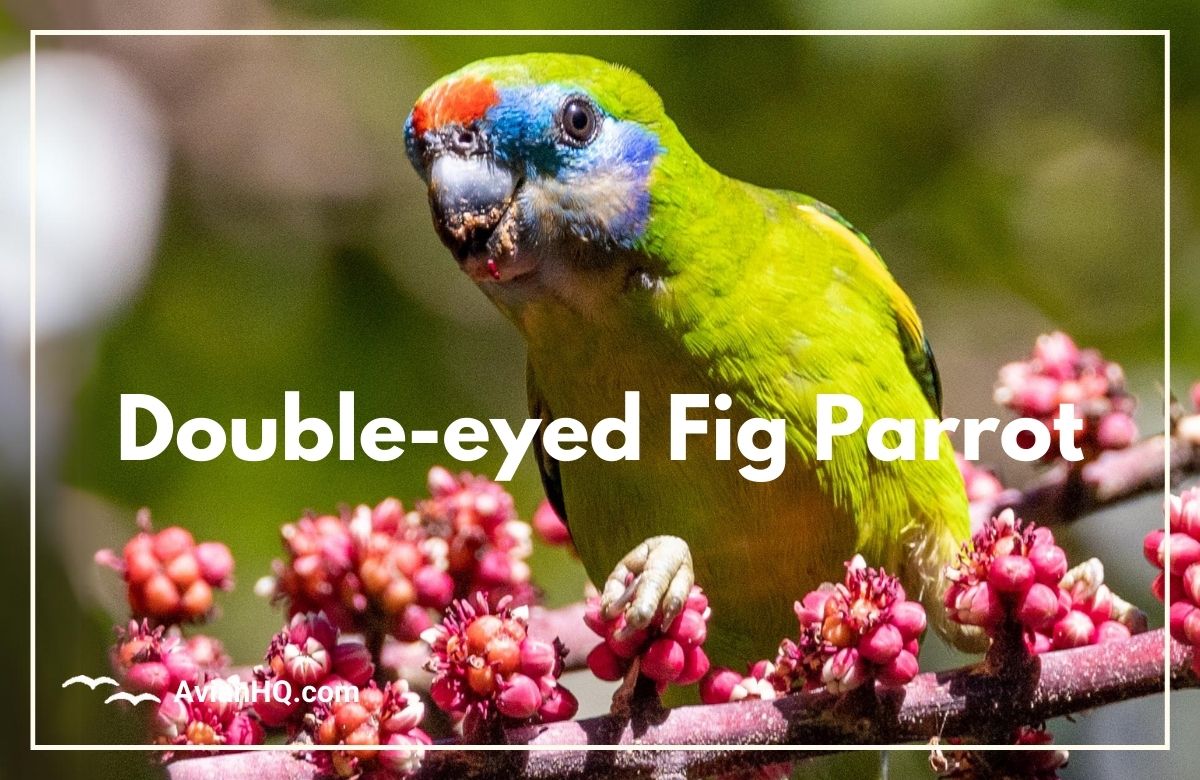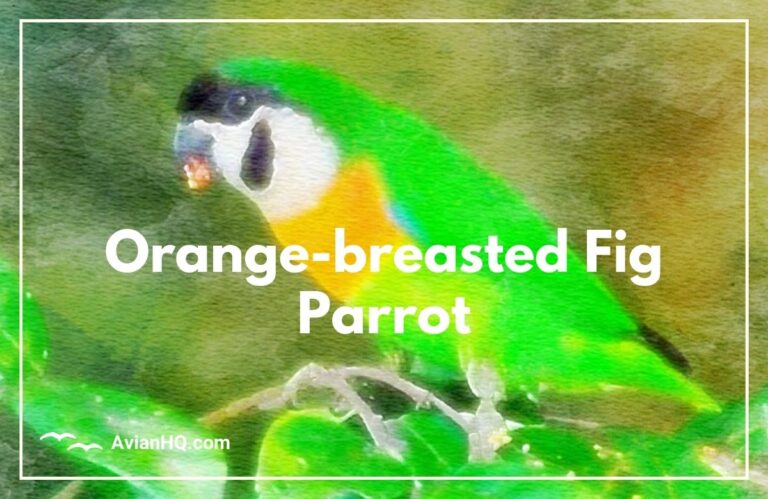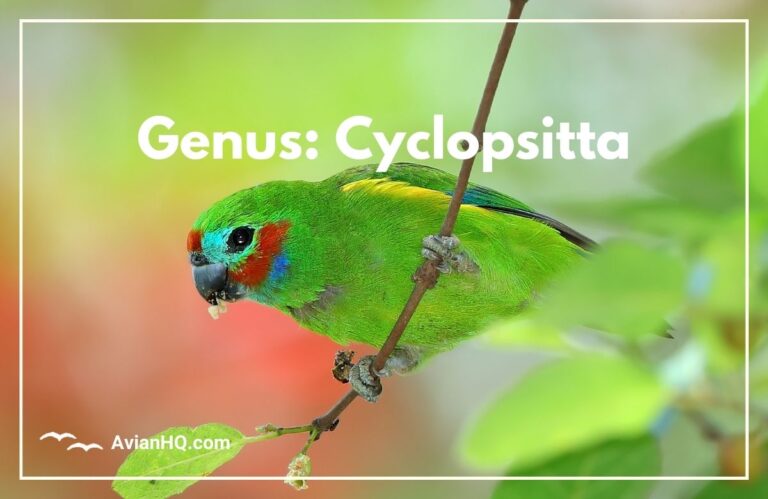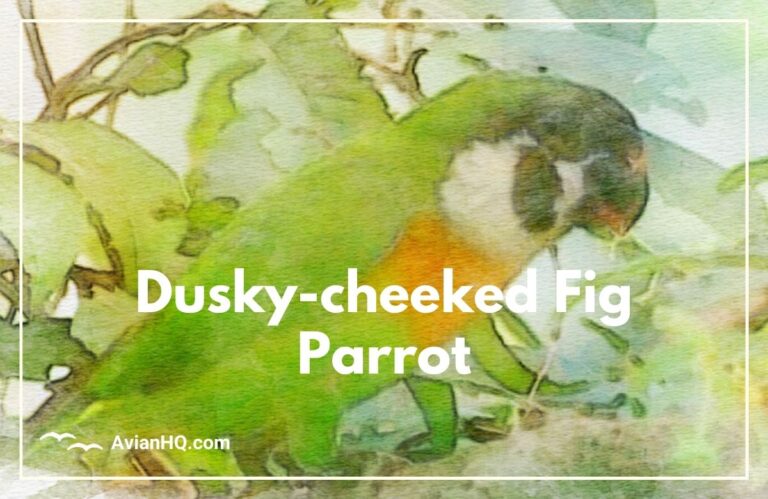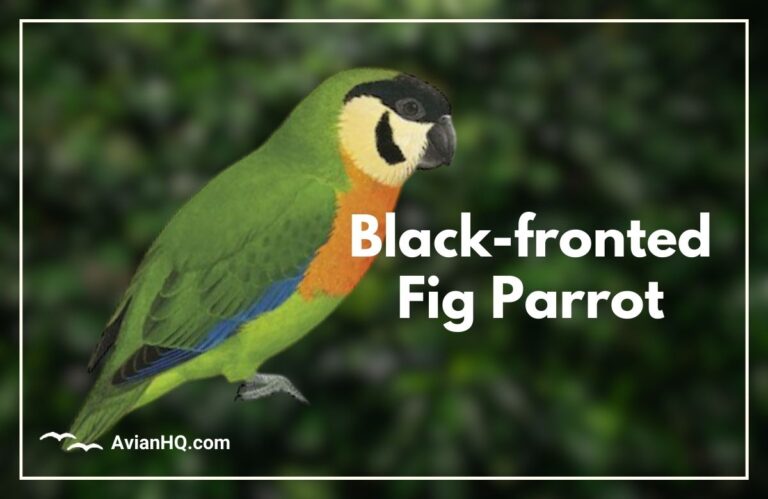Double-eyed Fig Parrot (Cyclopsitta diophthalma)
You first catch a glimpse of the Double-eyed Fig Parrot as it darts through the dense rainforest canopy. This vibrant green parrot, with bright red patches under its wings and tail, lives only in the lowland forests of New Guinea.
“The Double-eyed Fig Parrot’s splendid green and red plumage lets it easily blend into the lush tropical foliage.”
Weighing just 90-100 grams (3-3.5 ounces), this little parrot sports a proportionally large head and sharp, hooked beak perfectly adapted for cracking into fruit. Its namesake double-eye-rings of bare white skin encircle each eye, standing out against the rich green and red feathers.
As the Double-eyed Fig glides between branches using its short, rounded wings, you might notice the short blunt tail tip that gives it maneuverability in dense vegetation. If you hear a series of clear, whistling “woop” calls, that’s the flock communicating as they forage.
This ancient tropical rainforest is the only place in the world where wild Double-eyed Fig Parrots are found. Their secluded habitat and specialized diet make them a mysterious and vulnerable species. As few as 2,500 of these unique parrots remain.
This article will explore everything known about the elusive Double-eyed Fig Parrot, from its evolutionary past to modern-day threats. You’ll learn about its habitat, diet, behaviors and the conservation efforts urgently needed to protect this rare bird.
History and Taxonomy
The Double-eyed Fig Parrot entered the scientific literature rather recently. German naturalist Gustav Hartlaub first described this species in 1877, naming it Cyclopsitta diophthalma from specimens found in the Arfak Mountains of what is now Indonesia’s West Papua province.
“The genus name Cyclopsitta refers to the striking double eye-rings that encircle this parrot’s eyes.”
Hartlaub placed the Double-eyed Fig Parrot in its own unique genus Cyclopsitta due to its distinctive facial markings. Today it remains the sole species within this genus. Its species name diophthalma combines the Greek words “di” meaning two and “ophthalmos” for eye.
Some taxonomists classify the Double-eyed Fig as part of an ancient “Australasian group” that branched off from other parrot lineages over 30 million years ago. Its closest relatives may include other New Guinea species like the Red-breasted Pygmy Parrot.
Further analysis of the Double-eyed evolutionary history and genetic relationships to other parrots can help inform conservation efforts for this secluded rainforest species. Ongoing cataloging of Papua’s immense biodiversity continues to reveal new information about rare birds like this one.
Physical Appearance
The Double-eyed Fig Parrot is a small, stocky bird measuring just 5-6 inches (13-15 cm) long from the tip of its short tail to the end of its rounded wings. However, its large head and sharp hooked bill give it a somewhat outsized appearance.
Vibrant green feathers cover most of the body, with some subtle yellow scalloping on the neck. A red patch is visible under the wings and base of the tail when in flight. The face and throat area may take on a bluish or purple hue.
Males and females display close similarity, though some report the male’s red wing and tail patches as slightly more extensive. Juveniles resemble adults but with less vivid plumage in their first year.
This parrot’s most distinctive feature is the featherless white eye-ring skin that completely encircles each eye. The dark eyes peer out sharply from these “spectacles,” giving the species its common name. The bare facial skin may help reflect light while foraging, and also serves as a visual signal to other Double-eyed Figs.
Sturdy legs and zygodactyl feet (two toes facing forward, two back) allow the parrot to easily grip branches. Its short blunt tail provides maneuverability in dense rainforest vegetation. The Double-eyed Fig Parrot is well adapted to life in its secluded forest habitat.
Habitat and Distribution
The Double-eyed Fig Parrot resides solely in the lowland rainforests of New Guinea, the world’s second largest island. Its range spans both the Indonesian West Papua province and Papua New Guinea on the eastern half of the island.
Preferred habitat consists of tropical evergreen forests below 3,300 feet (1,000 meters) in elevation. Rare sightings come from rare mid-mountain forests up to 6,600 feet (2,000 meters). They occupy a mix of primary undisturbed forests as well as some secondary growth and swamp woods.
Across this range, annual rainfall exceeds 80 inches (2,000 mm) supporting lush forest. Temperatures remain warm year-round, averaging 75-90° F (24-32° C) at lower elevations where the parrot dwells. Cooler temperatures and less frequent rainfall at higher elevations limit its upward range.
Unfortunately, the Double-eyed Fig’s lowland rainforest home has declining acreage due to extensive logging and land conversion to oil palm plantations. Exact current population estimates are uncertain but likely number fewer than 2,500 individuals. Protecting remaining habitat is crucial for this range-restricted species’ survival.
Diet and Feeding
The Double-eyed Fig Parrot is aptly named for its diet centered around tropical figs within its lowland rainforest home. Figs from species like the Strangler Fig provide an important food source.
This parrot uses its sharp beak to break through the outer husks and access the soft seed-filled inner pulp of ripe figs. It likely swallows the tiny seeds as well while feeding. Smaller numbers also forage for berries and some floral nectar when figs become scarce.
“The Strangler Fig’s abundant fruit provides a vital food source for Double-eyed Figs during much of the year.”
Throughout most of the year, the parrot feeds mainly high in the rainforest canopy on ripening figs. During peak dry months when fig production declines, they may feed closer to the forest floor. Foraging flocks call back and forth while searching for fruiting trees.
Little study has focused on the diet and feeding ecology of this shy canopy species. More research can help identify key food plants to protect within its dwindling habitat. Supplemental planting of fruiting trees may aid struggling populations as forest loss continues.
Breeding and Reproduction
The breeding ecology and behaviors of the Double-eyed Fig Parrot remain poorly documented overall. However, some observations provide clues into their nesting habits.
Breeding season aligns with peak fig fruiting from at least December to March. Though rarely witnessed, they appear to nest in naturally formed tree hollows near the tops of very large canopy trees. Both parents likely cooperate in caring for young.
Average clutch size is estimated around 2-4 white eggs. The female incubates these small eggs within the nest hollow for just under a month. After hatching, both adults feed regurgitated fruit pulp to nestlings.
Young fledge the nest at 8-9 weeks old, still with immature plumage. Parents continue supplementary feeding as fledglings develop flying skills over several additional weeks. Family groups may remain together even as pairs re-nest in following seasons.
Research on wild Double-eyed Figs continues to slowly reveal breeding details that escaped scientists for so long. Installing camera traps or inspecting nest sites while climbing canopy towers can further expand knowledge to aid conservation efforts.
Behavior and Ecology
The Double-eyed Fig Parrot lives primarily in small, fast-moving flocks as it forages for fruit high in the rainforest canopy. Groups range from family units of just 6-10 birds up to larger flocks of 30+ individuals moving together.
They call constantly back and forth with high, whistling “woop” notes while feeding. These vocalizations likely help maintain contact and cohesion within constantly moving mixed flocks. Young birds memorize these contact calls as nestlings to recognize their flock.
Though agile climbers, these parrots use short, fast direct flights between trees. Their blunt tail and rounded wings provide maneuverability navigating a dense habitat. Available habitat likely limits flock sizes more than social dynamics.
Birds roost in dense vines or tree cavities together at night and stay together after breeding season ends. Predation rates likely increase for solitary birds compared to vigilant groups that can mob predators.
Little is published yet on breeding habits, territorial behaviors, or nesting ecology. Canopy access will allow more detailed documentation of daily activity patterns and social dynamics. Agile camera traps may continue revealing secrets of this shy species.
Conservation Status
The International Union for Conservation of Nature (IUCN) currently lists the Double-eyed Fig Parrot as Near Threatened on the Red List of Threatened Species. However, its status may warrant elevation to Vulnerable category in the near future.
Best estimates suggest global population numbers fewer than 2,500 mature birds, though data deficiency complicates accurate tallies. What is certain is that primary rainforest acreage continues declining across their native range.
Historic habitat loss occurred from subsistence farming practices and small-scale logging over past centuries. However, extensive modern mechanized logging, mining, and industrial oil palm agriculture rapidly accelerate deterioration.
In Indonesia, up to 80% primary forest loss affects accessible lowland habitat. Even protected areas experience degradation from illegal poaching for food and the pet trade. Climate shifts may also impact survival as precipitation patterns and storms intensify.
Conservation groups now advocate for expanded habitat protections and more equitable community forestry management. Studying the parrot’s key food plants and nesting ecology allows strategic guidance for preservation efforts. Sustainable development policies aimed at poverty reduction can alleviate pressure on the region’s dwindling forests.
Cultural Significance
Little documentation exists yet on the specific cultural or spiritual significance of the Double-eyed Fig Parrot among the region’s indigenous peoples. However, birds in general feature prominently in folk tales and rituals of forest tribes in New Guinea.
Various native languages likely have traditional names for this colorful canopy parrot. Some tribal groups may revere certain birds as spiritual embodiments of ancestors. Feathers, heads, or claws occasionally decorate ceremonial costumes conveying prestige.
Across the Asia-Pacific, indigenous groups practice complex hunting taboos that may offer protection for vulnerable species. Certain clans traditionally avoid consuming “totem” animals like cassowaries, crocodiles, or fruit bats. Similar undocumented food prohibitions may benefit rare birds like the Double-eyed Fig.
As scientists study this species, ethnographers should urgently document any traditional beliefs or knowledge that can further bolster modern conservation efforts. Preserving cultural diversity goes hand in hand with protecting biodiversity in these threatened forest ecosystems.
Conclusion
The vibrant green and red Double-eyed Fig Parrot remains one of the most mysterious birds in New Guinea’s lowland rainforests. Surviving alongside indigenous tribes for millennia thanks to the bounty of Strangler Figs, this ancient species now confronts an uncertain future.
Industrial-scale threats ranging from extensive logging to oil palm conversion decimate acreage of the parrot’s humid tropical habitat. Even protected lands experience degradation and illegal poaching amidst impoverished local economies. Fewer than 2,500 Double-eyed Figs likely persist across the island.
Concerted conservation efforts focused on this range-restricted bird can anchor initiatives that benefit indigenous forest peoples as well. Ecotourism, sustainable agriculture, and equitable community forest management provide pathways for poverty alleviation without sacrificing biodiversity.
Expanded habitat protections, partnerships with local groups, and responsible economic opportunities in isolated regions where the species occurs all remain essential to the Double-eyed Fig’s survival. Research that reveals more details on nesting needs and key food plants further informs strategic decision-making for conservationists.
With committed action guided by both modern science and traditional knowledge, there remains hope of preserving New Guinea’s lowland forests. The unique Double-eyed Fig Parrot serves as just one inspiring ambassador from the region’s stunning and still little-known biodiversity worth saving.

